Evaluating the Service Performance of Heavy Axle Load Ballasted Railway by Using Numerical Simulation Method
Abstract
:1. Introduction
2. Inverse Analysis Pertaining to LFWD Test
2.1. Overview of LFWD Test and Its Inverse Analysis
2.2. Three-Dimensional Numerical Model
2.2.1. Boundary Conditions
2.2.2. Track Substructure Properties Required for Structural Analysis
2.3. Result of Inverse Analysis
2.3.1. Analysis
2.3.2. Results
3. Dynamic Analysis
3.1. Three-Dimensional Numerical Model
3.1.1. Track Geometry and Materials
3.1.2. Train Loads
3.2. Validation Using Experimental Data
3.3. Result of Dynamic Analyses
3.3.1. Effect of Train Speed
3.3.2. Effect of Axle Load
3.3.3. Dynamic Response Attenuation in Soil
4. Evaluation of Service Performance
5. Conclusions
- (1)
- The LFWD, which has been proven to be a versatile and reliable non-destructive testing device for road pavements, can be a valuable tool to realize the evaluation of China’s HAL railway system. An agreement is noted between the 3D FE model and the deflection data, which further demonstrates that the proposed approach can be used to determine the resilient modulus with a satisfactory accuracy.
- (2)
- The effects of various factors on the dynamic response are notable. The vertical peak acceleration (Amax) at the bottom layer reduced by approximately 30–50% compared to that at the top layer, whereas the dynamic stress reduced by approximately 95%. Furthermore, the Amax and dynamic stress decayed with the depth exponentially and hyperbolically, respectively.
- (3)
- The method of service performance evaluation is established based on the results of the parametric study on the effects of varying v and F. Based on the recommendation that the critical stress ratio should be less 0.2, an endurance limit of v and F is assigned to ensure the long-term stability of the existing HAL railways. It was noted that F can be up to 260 kN, whereas v must be less than 60 km/h. However, if v needs to be increased, the corresponding F must be reduced to ensure service safety.
Author Contributions
Funding
Institutional Review Board Statement
Informed Consent Statement
Data Availability Statement
Conflicts of Interest
References
- Jiang, J.; Chen, Z.; Zhai, W.; Zhang, T.; Li, Y. Vibration characteristics of railway locomotive induced by gear tooth root crack fault under transient conditions. Eng. Fail. Anal. 2019, 108, 104285. [Google Scholar] [CrossRef]
- Lazorenko, G.; Kasprzhitskii, A.; Khakiev, Z.; Yavna, V. Dynamic behavior and stability of soil foundation in heavy haul railway tracks: A review. Constr. Build. Mater. 2019, 205, 111–136. [Google Scholar] [CrossRef]
- Mei, H.; Leng, W.; Nie, R.; Liu, W.; Chen, C.; Wu, X. Random distribution characteristics of peak dynamic stress on the subgrade surface of heavy-haul railways considering track irregularities. Soil Dyn. Earthq. Eng. 2019, 116, 205–214. [Google Scholar] [CrossRef]
- Yang, L.A.; Powrie, W.; Priest, J. Dynamic stress analysis of a ballasted railway track bed during train passage. J. Geotech. Geoenviron. Eng. 2009, 135, 680–689. [Google Scholar] [CrossRef]
- Lamas-Lopez, F.; Cui, Y.J.; Calon, N.; D’Aguiar, S.C.; De Oliveira, M.P.; Zhang, T. Track-bed mechanical behaviour under the impact of train at different speeds. Soil Found. 2016, 56, 627–639. [Google Scholar] [CrossRef]
- Yu, C.Y.; Tian, S.; Tang, L.; Ling, X.Z.; Zhou, G.Q. Finite element analysis on deformation of high embankment in heavy-haul railway subjected to freeze-thaw cycles. Sci. Cold Arid Reg. 2015, 7, 421–429. [Google Scholar]
- Xu, F.; Yang, Q.; Liu, W.; Leng, W.; Nie, R.; Mei, H. Dynamic stress of subgrade bed layers subjected to train vehicles with large axle loads. Shock Vibr. 2018, 2018, 2916096. [Google Scholar] [CrossRef]
- Mei, H.; Leng, W.; Nie, R.; Tu, R.; Li, Y.; Dong, J. Experimental research on the dynamic response characteristics of the transition subgrade induced by heavy-haul train passage. Proc. Inst. Mech. Eng. F. J. Rail Rapid Transit 2019, 233, 974–981. [Google Scholar] [CrossRef]
- Shi, J.; Hou, D. Failure analysis for railroad embankment under heavy haul wagon loads. Mechanics 2017, 23, 197–203. [Google Scholar] [CrossRef] [Green Version]
- Tang, L.; Kong, X.; Li, S.; Ling, X.; Ye, Y.; Tian, S. A preliminary investigation of vibration mitigation technique for the high-speed railway in seasonally frozen regions. Soil Dyn. Earthq. Eng. 2019, 127, 105841. [Google Scholar] [CrossRef]
- Wang, P.; Wang, L.; Chen, R.; Xu, J.; Xu, J.; Gao, M. Overview and outlook on railway track stiffness measurement. J. Mod. Transp. 2016, 24, 89–102. [Google Scholar] [CrossRef] [Green Version]
- Nabizadeh, H.; Hajj, E.Y.; Siddharthan, R.; Elfass, S.; Nimeri, N. Application of falling weight deflectometer for the estimation of in-situ shear strength parameters of subgrade layer. In Bearing Capacity of Roads, Railways and Airfields; CRC Press: Abingdon, UK, 2017; pp. 743–749. [Google Scholar]
- Haji Abdulrazagh, P.; Farzaneh, O.; Behnia, C. Evaluation of railway trackbed moduli using the rail falling weight test method and its backcalculation model. Proc. Inst. Mech. Eng. F J. Rail Rapid Transit 2019, 233, 431–447. [Google Scholar] [CrossRef]
- Burrow, M.P.N.; Chan, A.H.C.; Shein, A. Deflectometer-based analysis of ballasted railway tracks. Proc. Inst. Civil Eng. Geotech. Eng. 2007, 160, 169–177. [Google Scholar] [CrossRef]
- Sussmann, T.R., Jr.; Stark, T.D.; Wilk, S.T.; Thompson, H.B. Track support measurements for improved resiliency of railway infrastructure. Transp. Res. Rec. 2017, 2607, 54–61. [Google Scholar] [CrossRef]
- Boler, H.; Mishra, D.; Hou, W.; Tutumluer, E. Understanding track substructure behavior: Field instrumentation data analysis and development of numerical models. Transp. Geotech. 2018, 17, 109–121. [Google Scholar] [CrossRef]
- Giuntoli, S.; Pratelli, C.; Betti, G.; Marradi, A. Field performance evaluation of unbound granular materials using the Fast Falling Weight Deflectometer. In Proceedings of the 5th International Conference on Road and Rail Infrastructure (CETRA 2018), Zadar, Croatia, 17–19 May 2018; pp. 417–423. [Google Scholar]
- Haji Abdulrazagh, P.; Hendry, M.T. A Case study of use of a falling weight deflectometer to investigate railway infrastructure constructed upon soft subgrades. Can. Geotech. J. 2016, 53, 1991–2000. [Google Scholar] [CrossRef]
- Li, D.; Selig, E.T. Evaluation of railway subgrade problems. Transp. Res. Rec. 1995, 1489, 17. [Google Scholar]
- Kaynia, A.M.; Madshus, C.; Zackrisson, P. Ground vibration from high-speed trains: Prediction and countermeasure. J. Geotech. Geoenviron. Eng. 2000, 126, 531–537. [Google Scholar] [CrossRef]
- Gräbe, P.J.; Shaw, F.J. Design life prediction of a heavy haul track foundation. Proc. Inst. Mech. Eng. F J. Rail Rapid Transit 2010, 224, 337–344. [Google Scholar] [CrossRef]
- Li, D. 25 years of heavy axle load railway subgrade research at the Facility for Accelerated Service Testing (FAST). Transp. Geotech. 2018, 17, 51–60. [Google Scholar] [CrossRef]
- Wei, Z.; Núñez, A.; Boogaard, A.; Dollevoet, R.; Li, Z. Method for evaluating the performance of railway crossing rails after long-term service. Tribol. Int. 2018, 123, 337–348. [Google Scholar] [CrossRef] [Green Version]
- Su, H.; Pun, C.L.; Mutton, P.; Kan, Q.; Yan, W. Numerical study on the ratcheting performance of heavy haul rails in curved tracks. Wear 2019, 436, 203026. [Google Scholar] [CrossRef]
- Li, P.; Xianzhang, L.; Feng, Z.; Yan, L.; Yingying, Z. Field testing and analysis of embankment vibrations induced by heavy haul trains. Shock Vibr. 2017, 2017, 7410836. [Google Scholar] [CrossRef] [Green Version]
- Li, P. Dynamic Response and Long-Term Accumulated Deformation Characteristics of Subgrade for Heavy Haul Railway. Ph.D. Thesis, Harbin Institute of Technology, Harbin, China, 2018. [Google Scholar]
- Asli, C.; Feng, Z.Q.; Porcher, G.; Rincent, J.J. Back-calculation of elastic modulus of soil and subgrade from portable falling weight deflectometer measurements. Eng. Struct. 2012, 34, 1–7. [Google Scholar] [CrossRef]
- Deblois, K.; Bilodeau, J.P.; Dore, G. Use of falling weight deflectometer time history data for the analysis of seasonal variation in pavement response. Can. J. Civ. Eng. 2010, 37, 1224–1231. [Google Scholar] [CrossRef]
- Ahmed, A.T.; Khalid, H.A. Backcalculation models to evaluate light falling weight deflectometer moduli of road foundation layer made with bottom ash waste. Transp. Res. Rec. 2011, 2227, 63–70. [Google Scholar] [CrossRef]
- Tian, S.; Li, S.; Tang, L.; Ling, X.Z.; Kong, X.X. Numerical Investigation of vibrational acceleration level for a ballasted railway track during train passage in seasonally frozen regions. In Advances in Environmental Vibration and Transportation Geodynamics. Lecture Notes in Civil Engineering; Tutumluer, E., Chen, X., Xiao, Y., Eds.; Springer: Singapore, 2020; Volume 6. [Google Scholar]
- Tam, W.S.; Brown, S.F. Use of falling weight deflectometer for in situ evaluation of granular materials in pavements. Proc. Aus. Road Res. Board 1988, 14, 155–163. [Google Scholar]
- Garg, V.K.; Vukkipati, R.V. Dynamics of Railway Vehicle Systems; Academic Press: Toronto, CA, USA, 1984. [Google Scholar]
- Hamid, R.N.; Morteza, A.; Hamid, H. Numerical analysis of ground vibration induced by underground train movement. Tunn. Undergr. Space Technol. 2012, 29, 1–9. [Google Scholar]
- Connolly, D.; Giannopoulos, A.; Forde, M.C. Numerical modelling of ground borne vibrations from high speed rail lines on embankments. Soil Dyn. Earthq. Eng. 2013, 46, 13–19. [Google Scholar] [CrossRef] [Green Version]
- Jianxin, L.; Pengmao, L.; Xiaozhong, T.; Chuanghua, C. Dynamic response of railway subgrade by infinite element method. Electron. J. Geotech. Eng. 2016, 21, 4151–4162. [Google Scholar]
- TB 10625-2017; Code for Design of Heavy Haul Railway. China Railway Third Survey and Design Institute Group: Beijing, China, 2017. (In Chinese)
- Dong, J.; Yang, Y.; Wu, Z.H. Propagation characteristics of vibrations induced by heavy-haul trains in a loess area of the North China Plains. J. Vibr. Control 2019, 25, 882–894. [Google Scholar] [CrossRef]
- Miao, L.Q.; Feng, H.P.; Yue, Z.R.; Miao, X.G. Deformation characteristics of heavy-haul railway subgrade under large axle load. Subgrade Eng. 2015, 3, 35–37. (In Chinese) [Google Scholar]


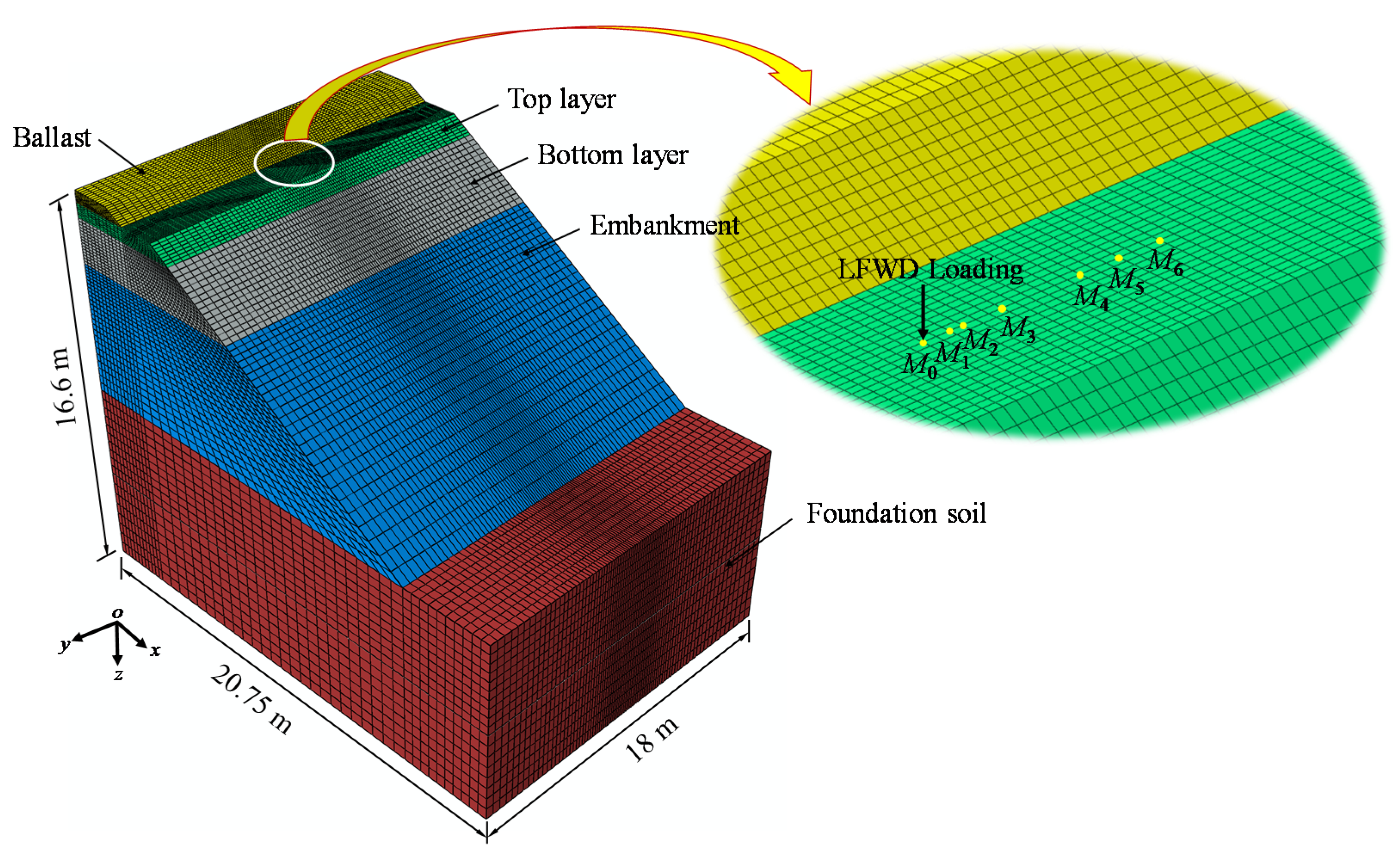
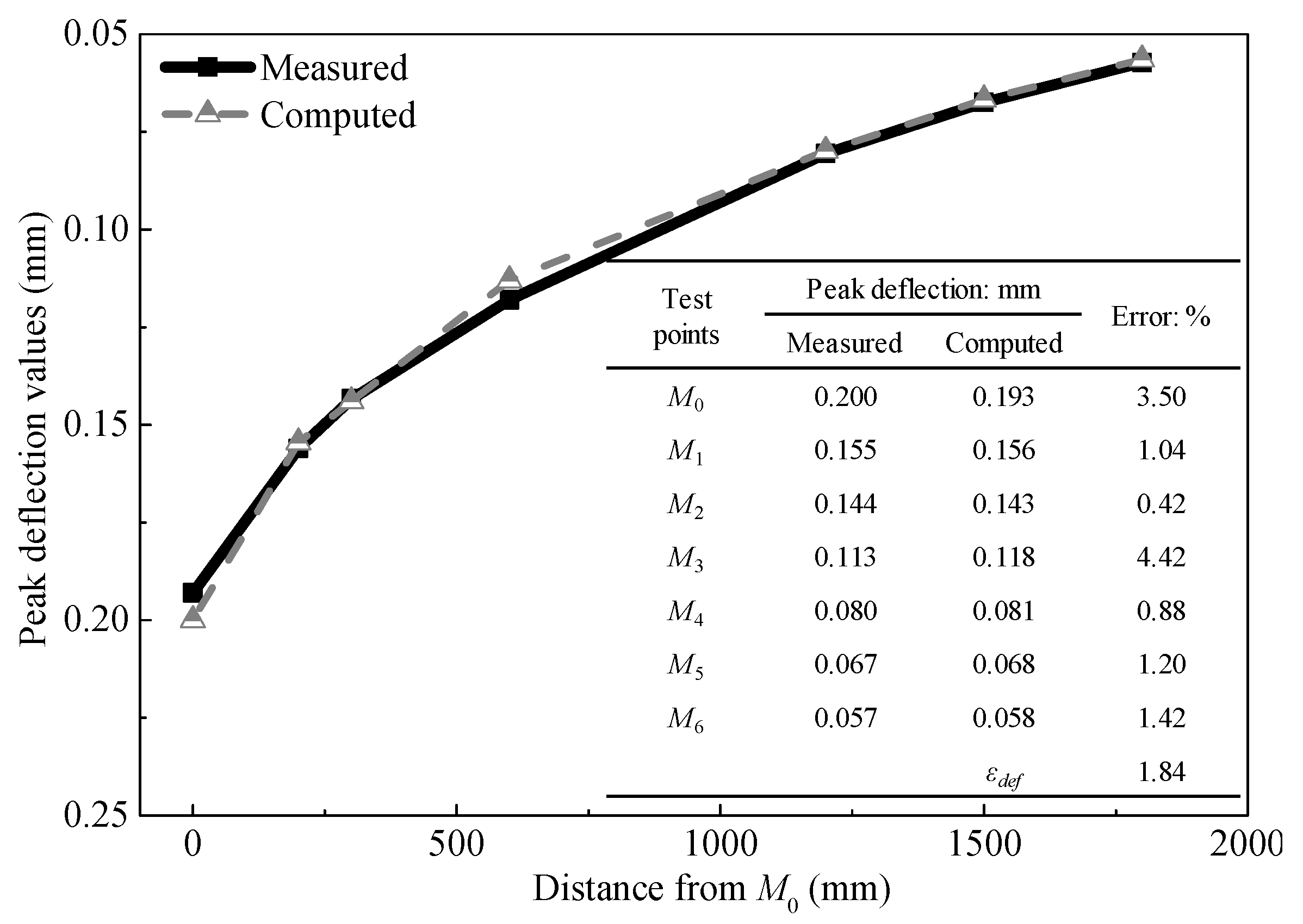
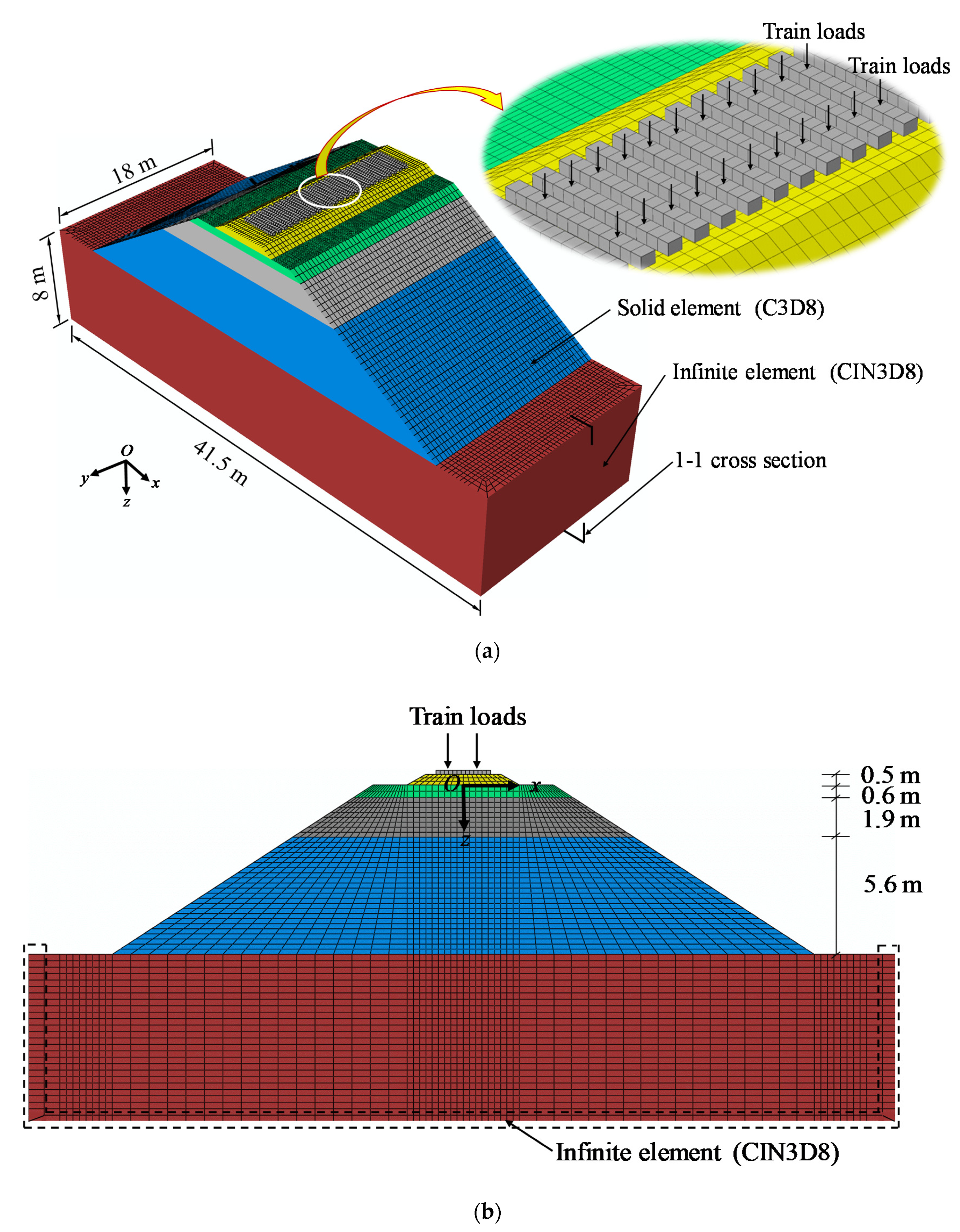
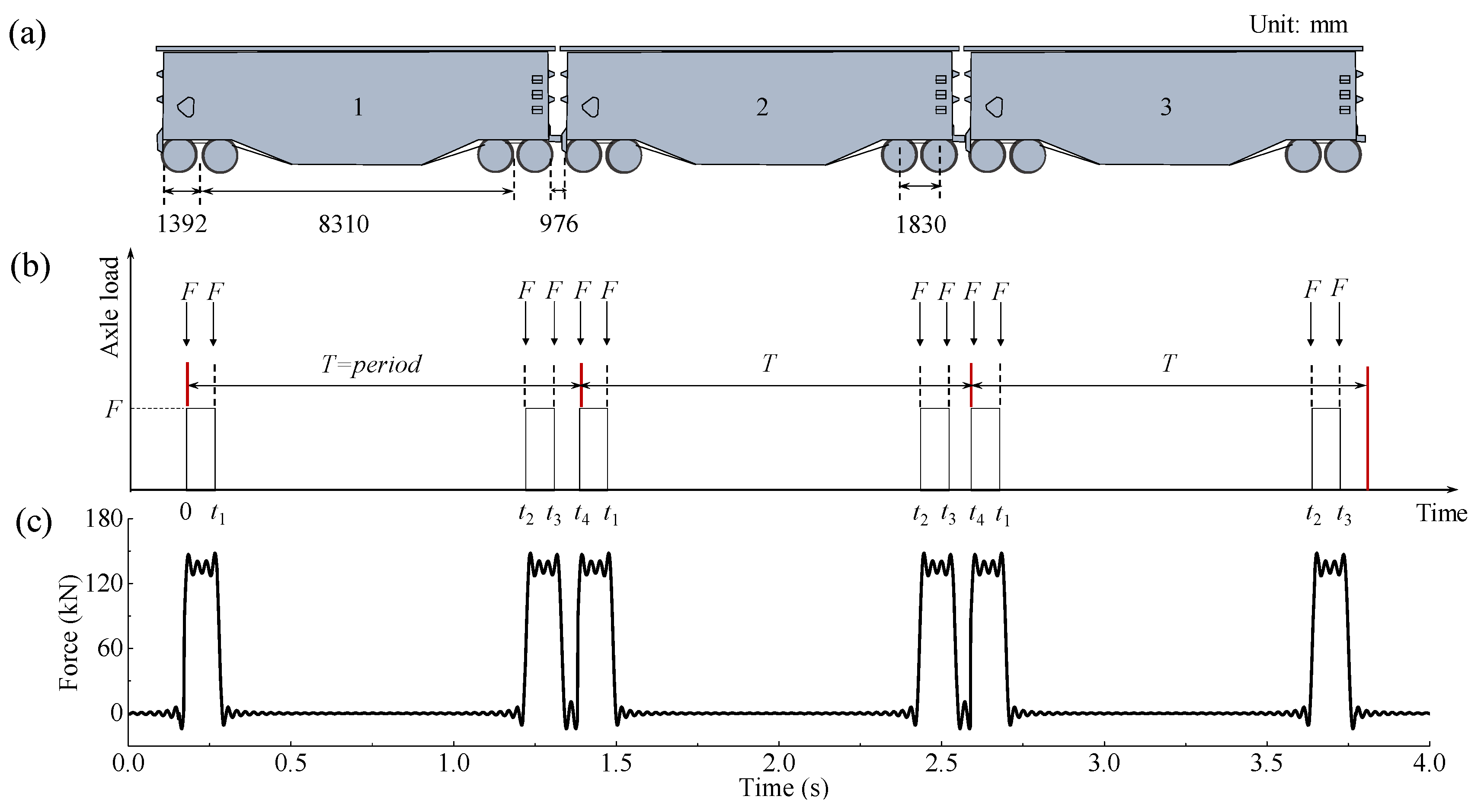
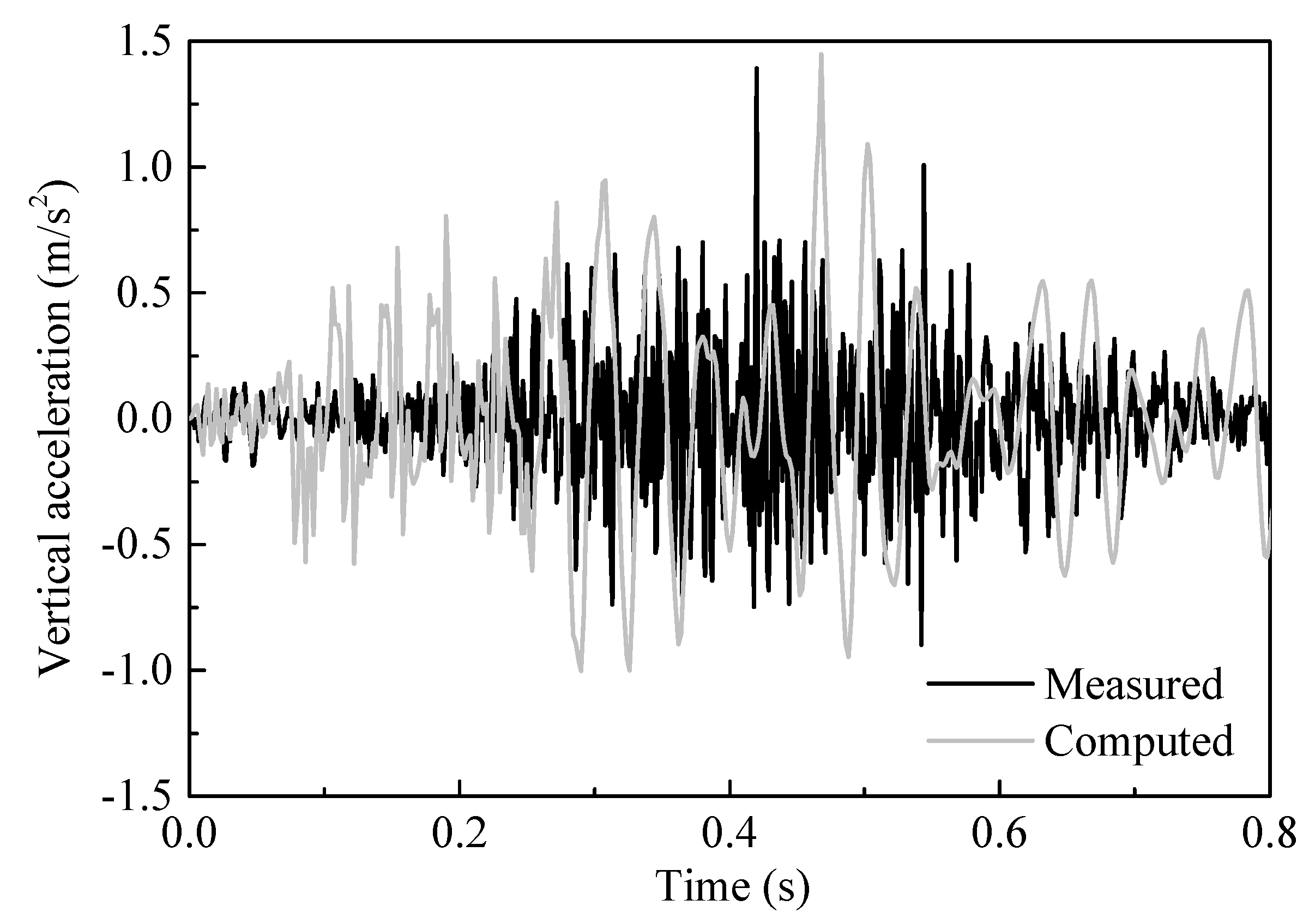



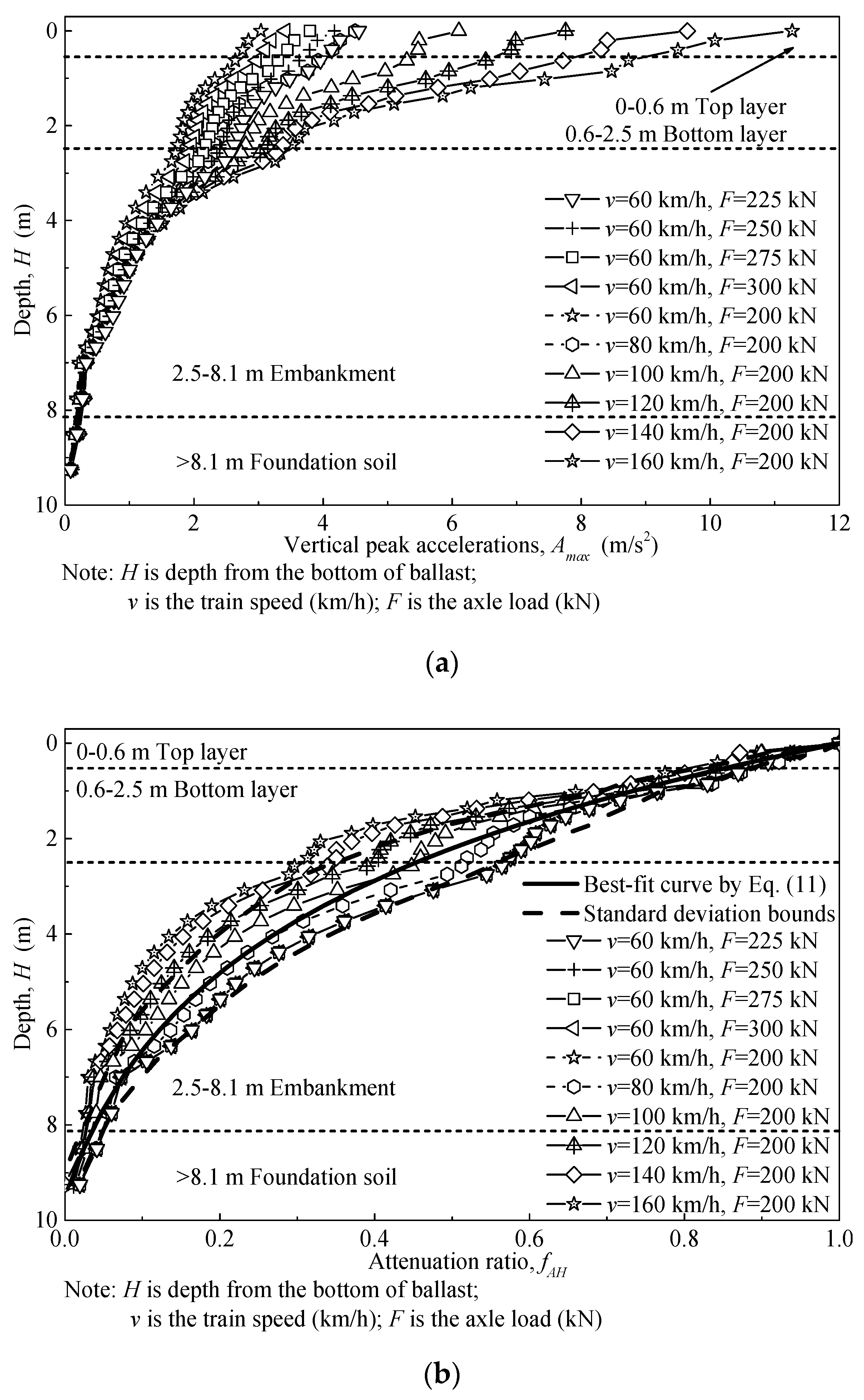


| Sleeper | Young’s Modulus, E (GPa) | 30 |
| Poisson’s ratio | 0.18 | |
| Density (kg/m3) | 2500 | |
| Length × Width × Height (m) | 2.6 × 0.25 × 0.2 | |
| Ballast | Young’s Modulus, E (MPa) | 180 |
| Poisson’s ratio | 0.25 | |
| Density (kg/m3) | 1700 | |
| Top layer | 1 Base modulus K1 (MPa) | 275 |
| 1 Exponent K2 | 0.25 | |
| Poisson’s ratio | 0.3 | |
| Density (kg/m3) | 1950 | |
| Bottom layer | 1 Base modulus K1 (MPa) | 196.6 |
| 1 Exponent K2 | 0.2 | |
| Poisson’s ratio | 0.25 | |
| Density (kg/m3) | 2000 | |
| Embankment | 1 Base modulus K1 (MPa) | 186.1 |
| 1 Exponent K2 | 0.2 | |
| Poisson’s ratio | 0.25 | |
| Density (kg/m3) | 2000 | |
| Foundation soil | Young’s Modulus, E (MPa) | 120 |
| Poisson’s ratio | 0.27 | |
| Density (kg/m3) | 2100 |
Publisher’s Note: MDPI stays neutral with regard to jurisdictional claims in published maps and institutional affiliations. |
© 2022 by the authors. Licensee MDPI, Basel, Switzerland. This article is an open access article distributed under the terms and conditions of the Creative Commons Attribution (CC BY) license (https://creativecommons.org/licenses/by/4.0/).
Share and Cite
Tian, S.; Ling, X.; Li, T.; Chan, A.; Georgescu, I.-R. Evaluating the Service Performance of Heavy Axle Load Ballasted Railway by Using Numerical Simulation Method. Appl. Sci. 2022, 12, 2539. https://doi.org/10.3390/app12052539
Tian S, Ling X, Li T, Chan A, Georgescu I-R. Evaluating the Service Performance of Heavy Axle Load Ballasted Railway by Using Numerical Simulation Method. Applied Sciences. 2022; 12(5):2539. https://doi.org/10.3390/app12052539
Chicago/Turabian StyleTian, Shuang, Xianzhang Ling, Ting Li, Andrew Chan, and Ionut-Razvan Georgescu. 2022. "Evaluating the Service Performance of Heavy Axle Load Ballasted Railway by Using Numerical Simulation Method" Applied Sciences 12, no. 5: 2539. https://doi.org/10.3390/app12052539





